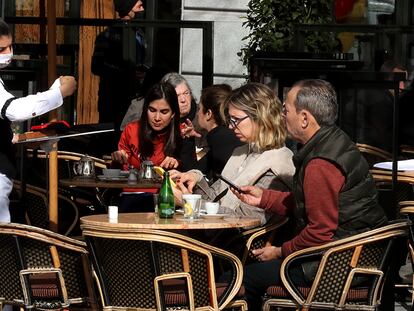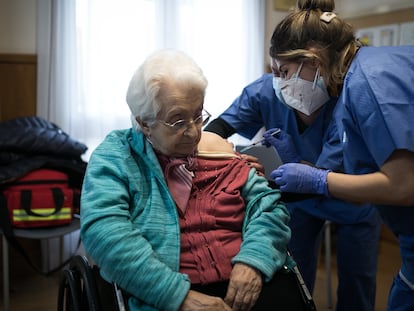Madrid lags behind as third coronavirus wave eases in Spain
The region is the only territory in the country where the 14-day cumulative number of cases per 100,000 inhabitants is still over 500

The latest coronavirus report from the central Health Ministry has once again confirmed the downward trend of this third wave of the pandemic. According to the data, released on Tuesday evening, there were 10,057 new cases reported by the country’s regions and a 14-day cumulative number of coronavirus cases per 100,000 inhabitants of 386.
The figures are falling fast, but the cumulative incidence continues to be above the 250-mark, considered to be “extreme risk” by the Spanish government. If the downward trend continues, the data will soon reach the low points seen at the end of the second wave, back at the beginning of December. The number of new cases reported yesterday is roughly 6,000 down on the same day last week, when 16,402 infections were reported. The seven-day trend suggests that the incidence will continue to fall.
The ministry report added 530 victims to the overall death toll, which now stands at 65,979
Madrid is the only region that continues to show a 14-day cumulative number of coronavirus cases per 100,000 inhabitants of above 500, with 529. The fast descent being seen in practically all of Spain is yet to be registered in Madrid, which has some of the most lenient coronavirus restrictions in the whole country.
The only territory in Spain with worse epidemiological data than Madrid is the North African exclave city of Melilla, which has 588 cases per 100,000 inhabitants, according to Tuesday’s report. Elsewhere, there are four more regions that are above 400: Andalusia, Aragón, Castilla y León and Valencia, plus Spain’s other North African city, Ceuta.
At the other end of the scale are the Canary and Balearic islands, which are below 200. The rest of Spain’s territories have an incidence rate between 200 and 400, which is close to the “extreme risk” threshold in the former case and to “very high” in the latter. There are other factors that are used to establish the risk level, however, such as the positivity rate – i.e. the percentage of coronavirus tests that come back positive. This is also falling and over the last week has come in at 8.2%. Spain’s target is to get below 10%, but the World Health Organization puts the bar at 5% for a territory to consider the epidemic to be under control.
Another indicator that is considered is the pressure on hospitals. In general terms, this is also falling. Just over 15% of normal hospital beds are occupied by Covid-19 patients, which is now below the worst moments of the second wave, in mid-November. The fall is slower for intensive care unit (ICU) beds, and the percentage remains higher than it was late last year at 37.3%.
This was one of the reasons cited on Monday by Fernando Simón, the director of the Health Ministry’s Coordination Center for Health Alerts (CCAES), to be cautious when it comes to relaxing coronavirus restrictions across the country. A new spike, a fourth wave, would come at a time when hospitals continue to be under a lot of pressure and with scant margin to deal with the most serious Covid patients.
A total of 10,057 new cases were reported by the country’s regions on Tuesday, roughly 6,000 down on the same day last week
The ministry report added 530 victims to the overall death toll, bringing the official total since the start of the pandemic to 65,979. The real figure, however, is likely to be much higher given the lack of testing that was available at the outset of the health crisis. Taking into account excess mortality figures from the National Statistics Institute (INE), the total death toll from Covid-19 is likely closer to 90,000.
The additions to the death toll in the ministry’s reports do not account for Covid fatalities in the previous 24 hours, but rather all of those that are registered, usually with a delay. If the average number of deaths over the previous seven days is taken into account, the figure on Tuesday was 176, consolidating a downward trend that began a week ago. This is the last data point to improve once new infections begin to fall.
English version by Simon Hunter.
Tu suscripción se está usando en otro dispositivo
¿Quieres añadir otro usuario a tu suscripción?
Si continúas leyendo en este dispositivo, no se podrá leer en el otro.
FlechaTu suscripción se está usando en otro dispositivo y solo puedes acceder a EL PAÍS desde un dispositivo a la vez.
Si quieres compartir tu cuenta, cambia tu suscripción a la modalidad Premium, así podrás añadir otro usuario. Cada uno accederá con su propia cuenta de email, lo que os permitirá personalizar vuestra experiencia en EL PAÍS.
¿Tienes una suscripción de empresa? Accede aquí para contratar más cuentas.
En el caso de no saber quién está usando tu cuenta, te recomendamos cambiar tu contraseña aquí.
Si decides continuar compartiendo tu cuenta, este mensaje se mostrará en tu dispositivo y en el de la otra persona que está usando tu cuenta de forma indefinida, afectando a tu experiencia de lectura. Puedes consultar aquí los términos y condiciones de la suscripción digital.
More information
Últimas noticias
Welcome to the post-religion era: The idea of Christianity as the absolute truth has become obsolete
‘I thought you would like it’: The risky sexual practice popularized by TV shows and TikTok
The digitalization of tourism: ‘They promise experiences and gave us the worst possible one’
Mexican peso defies uncertainty with forecasts of a new period of stability in 2026
Most viewed
- Sinaloa Cartel war is taking its toll on Los Chapitos
- Reinhard Genzel, Nobel laureate in physics: ‘One-minute videos will never give you the truth’
- Oona Chaplin: ‘I told James Cameron that I was living in a treehouse and starting a permaculture project with a friend’
- Why the price of coffee has skyrocketed: from Brazilian plantations to specialty coffee houses
- Silver prices are going crazy: This is what’s fueling the rally











































